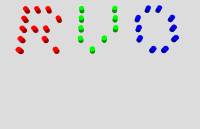1
2
3
4
5
6
7
8
9
10
11
12
13
14
15
16
17
18
19
20
21
22
23
24
25
26
27
28
29
30
31
32
33
34
35
36
37
38
39
40
41
42
43
44
45
46
47
48
49
50
51
52
53
54
55
56
57
58
59
60
61
62
63
64
65
66
67
68
69
70
71
72
73
74
75
76
77
78
79
80
81
82
83
84
85
86
87
88
89
90
91
92
93
94
95
96
97
98
99
100
101
102
103
104
105
106
107
108
109
110
111
112
113
114
115
116
117
118
119
120
121
122
123
124
125
126
127
128
129
130
131
132
133
134
135
136
137
138
139
140
141
142
143
144
145
146
147
148
149
150
151
152
153
154
155
156
157
158
159
160
161
162
163
164
165
166
167
168
169
170
171
172
173
174
175
176
177
178
179
180
181
182
183
184
185
186
187
188
189
190
191
192
193
194
195
196
197
198
199
200
201
202
203
204
205
206
207
208
209
210
211
212
213
214
215
216
217
218
| using System.Text;
using TMPro;
using UnityEngine;
namespace Test
{
[ExecuteAlways]
public class TMPTest : TextMeshPro
{
private string originText = string.Empty;
public override string text
{
get => originText;
set
{
originText = value;
StringBuilder strb = new StringBuilder();
var unicodes = originText.ToCharArray();
for(int i = 0;i < unicodes.Length; ++i)
{
var curChar = unicodes[i];
var curVal = (int)curChar;
if ((i + 1) < unicodes.Length && IsEmojiHead(curVal))
{
i++;
var realVal = ToEmojiVal(curVal, unicodes[i]);
if ((i + 1) < unicodes.Length)
{
curChar = unicodes[i + 1];
if ((i + 2) < unicodes.Length && IsEmojiHead(curVal))
{
i+=2;
var tmpStrb = new StringBuilder();
tmpStrb.AppendFormat("{0:x4}", realVal);
realVal = ToEmojiVal(curVal, unicodes[i]);
tmpStrb.Append('-');
tmpStrb.AppendFormat("{0:x4}", realVal);
var unicodeVal = (uint)TMP_TextUtilities.StringHexToInt(tmpStrb.ToString());
bool isUsingAlternativeTypeface;
TMP_TextElement character = GetTextElement(unicodeVal, m_currentFontAsset, m_FontStyleInternal, m_FontWeightInternal, out isUsingAlternativeTypeface);
if (character != null)
{
strb.AppendFormat("<sprite={0}>", character.glyphIndex);
}
else
{
strb.Append(unicodes[i - 3]);
strb.Append(unicodes[i - 2]);
strb.Append(curChar);
strb.Append(unicodes[i]);
}
}
}
else
{
strb.Append(curChar);
strb.Append(unicodes[i]);
}
}
else strb.Append(curChar);
}
base.text = strb.ToString();
}
}
private bool IsEmojiHead(int val)
{
return val >= 0xD800 && val <= 0xDBFF;
}
private int ToEmojiVal(int head,int end)
{
return 0x10000 + (head - 0xD800) * 0x400 + (end - 0xDC00);
}
TMP_TextElement GetTextElement(uint unicode, TMP_FontAsset fontAsset, FontStyles fontStyle, FontWeight fontWeight, out bool isUsingAlternativeTypeface)
{
TMP_Character character = TMP_FontAssetUtilities.GetCharacterFromFontAsset(unicode, fontAsset, false, fontStyle, fontWeight, out isUsingAlternativeTypeface);
if (character != null)
return character;
if (fontAsset.fallbackFontAssetTable != null && fontAsset.fallbackFontAssetTable.Count > 0)
character = TMP_FontAssetUtilities.GetCharacterFromFontAssets(unicode, fontAsset, fontAsset.fallbackFontAssetTable, true, fontStyle, fontWeight, out isUsingAlternativeTypeface);
if (character != null)
{
return character;
}
if (fontAsset.instanceID != m_fontAsset.instanceID)
{
character = TMP_FontAssetUtilities.GetCharacterFromFontAsset(unicode, m_fontAsset, false, fontStyle, fontWeight, out isUsingAlternativeTypeface);
if (character != null)
{
m_currentMaterialIndex = 0;
m_currentMaterial = m_materialReferences[0].material;
return character;
}
if (m_fontAsset.fallbackFontAssetTable != null && m_fontAsset.fallbackFontAssetTable.Count > 0)
character = TMP_FontAssetUtilities.GetCharacterFromFontAssets(unicode, fontAsset, m_fontAsset.fallbackFontAssetTable, true, fontStyle, fontWeight, out isUsingAlternativeTypeface);
if (character != null)
{
return character;
}
}
if (m_spriteAsset != null)
{
TMP_SpriteCharacter spriteCharacter = TMP_FontAssetUtilities.GetSpriteCharacterFromSpriteAsset(unicode, m_spriteAsset, true);
if (spriteCharacter != null)
return spriteCharacter;
}
if (TMP_Settings.fallbackFontAssets != null && TMP_Settings.fallbackFontAssets.Count > 0)
character = TMP_FontAssetUtilities.GetCharacterFromFontAssets(unicode, fontAsset, TMP_Settings.fallbackFontAssets, true, fontStyle, fontWeight, out isUsingAlternativeTypeface);
if (character != null)
{
return character;
}
if (TMP_Settings.defaultFontAsset != null)
character = TMP_FontAssetUtilities.GetCharacterFromFontAsset(unicode, TMP_Settings.defaultFontAsset, true, fontStyle, fontWeight, out isUsingAlternativeTypeface);
if (character != null)
{
return character;
}
if (TMP_Settings.defaultSpriteAsset != null)
{
TMP_SpriteCharacter spriteCharacter = TMP_FontAssetUtilities.GetSpriteCharacterFromSpriteAsset(unicode, TMP_Settings.defaultSpriteAsset, true);
if (spriteCharacter != null)
return spriteCharacter;
}
if (character == null)
{
character = TMP_FontAssetUtilities.GetCharacterFromFontAsset(unicode, m_currentFontAsset, true, m_FontStyleInternal, m_FontWeightInternal, out isUsingAlternativeTypeface);
if (character == null)
{
if (TMP_Settings.fallbackFontAssets != null && TMP_Settings.fallbackFontAssets.Count > 0)
character = TMP_FontAssetUtilities.GetCharacterFromFontAssets(unicode, m_currentFontAsset, TMP_Settings.fallbackFontAssets, true, m_FontStyleInternal, m_FontWeightInternal, out isUsingAlternativeTypeface);
}
if (character == null)
{
if (TMP_Settings.defaultFontAsset != null)
character = TMP_FontAssetUtilities.GetCharacterFromFontAsset(unicode, TMP_Settings.defaultFontAsset, true, m_FontStyleInternal, m_FontWeightInternal, out isUsingAlternativeTypeface);
}
if (character == null)
{
unicode = 32;
character = TMP_FontAssetUtilities.GetCharacterFromFontAsset(unicode, m_currentFontAsset, true, m_FontStyleInternal, m_FontWeightInternal, out isUsingAlternativeTypeface);
}
if (character == null)
{
unicode = 0x03;
character = TMP_FontAssetUtilities.GetCharacterFromFontAsset(unicode, m_currentFontAsset, true, m_FontStyleInternal, m_FontWeightInternal, out isUsingAlternativeTypeface);
}
}
return character;
}
#if UNITY_EDITOR
protected override void OnValidate()
{
if (base.text != originText)
text = base.text;
}
#endif
}
}
|







